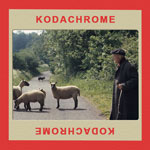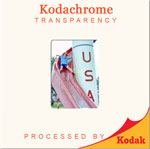Calculator!

A slide is a specially mounted transparency intended for projection onto a screen using a slide projector, allowing the photograph to be viewed by a large audience at once. The most common form is the 35mm slide but many others exist including 110 and 126 formats. All come mounted in 2x2" cardboard or plastic mounts.
Kodak was the first commercially successful company to produce a slide film for photographers called Kodachrome. It was introduced in 1936 for use in 35mm still cameras. Amateurs who owned projection equipment used slide film extensively because the cost of projection equipment and slide film was offset by not having to pay for prints. Eventually, print quality improved and prices decreased, and, by the 1970s, color negative film and color prints had largely displaced slides as the primary method of amateur photography.
Until about 1995, color slide film was preferred for publication, and was widely used in commercial and advertising photography, sports, stock and nature photography. Digital media has gradually replaced slide film

35mm is by far the most common slide film format. Kodachrome was the first format to come out, followed by Ektachrome, Fujichrome and Agfachrome. 35mm slides can come in a wide variety of 2" x 2" mounts, the most common is cardboard, but plastic and glass are also fairly common to see.

Super 35mm uses the same film as regular 35mm, however Super 35 utilizes more of films picture area. Super 35 uses a portion of the film the movie industry set aside for the soundtrack in early movies.

Half frame film squeezes 2 pictures into the same space as a single 35mm frame. Because of this, one could take twice as many pictures with the same roll of 35mm film. For example, you could get 72 pictures of a standard 36-exposure roll of film. Because this film is half the size of standard 35mm film, we recommend scanning at a higher resolution to capture sufficient detail.

The name "126" was intended to show the images were 26mm square, however the image size is actually 28mm square, but reduced to approximately 26.5mm square by masking from the slide mount. The film was originally available in 12 and 20 image lengths. It was introduced in 1963 and is generally associated with low-end point and shoot cameras.

The 127 format was introduced by Kodak in 1912 as a compact alternative to larger portable cameras using medium format (120) film. Slides shot on 127 film were often preferred over 35mm at tourist gift shops because of the larger photo area and square dimensions. This larger film size will require some cropping but are still scannable with our equipment.

110 is a cartridge-based film that was introduced by Kodak in 1972 and is essentially a miniaturised version of Kodak's earlier 126 film format. Most 110 cameras were made cheaply, with mediocre lenses and rudimentary exposure control, because of this, it is difficult to make quality enlargements. We always scan this film format at our highest (4000 DPI) resolution.

